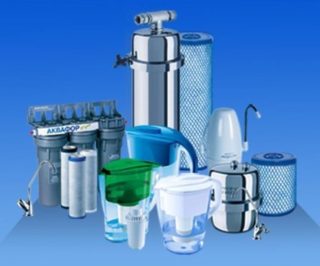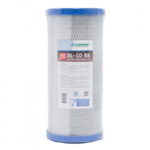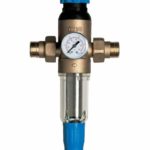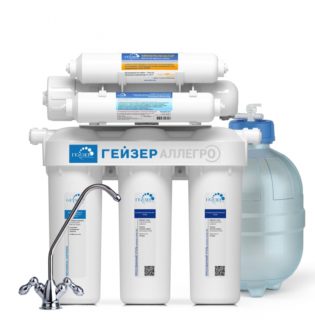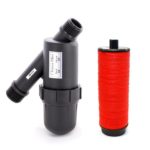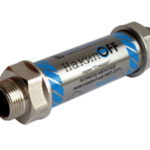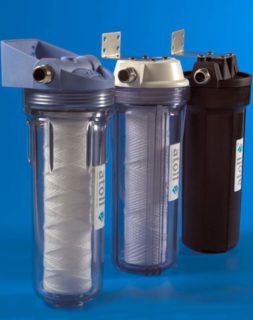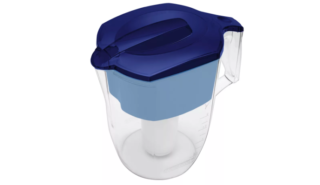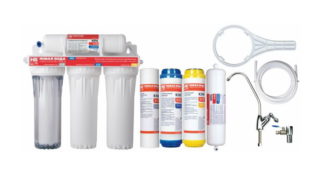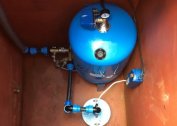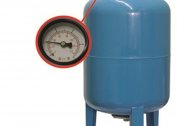Water from a central water supply system or well contains impurities that are harmful to human health. Chemical analysis reveals heavy metals, organic compounds, a large amount of chlorine, pathogenic microorganisms. A multi-stage cold water filter traps suspended solids and solutes. Depending on the device module, the liquid has a different degree of purification. Information about the types of filters and the principle of their operation will help in choosing the best option.
Purpose and use of filters for water treatment
Filters are devices that purify water from undissolved sediment, chemical and organic impurities, heavy metals, chlorine, and bacteria. Exceeding sanitary standards for these parameters is seriously harmful to health. Hard water with calcium and magnesium causes the appearance of scale on the heating elements of household appliances. This shortens their service life. Prepared water is supplied to the city apartments; it needs additional treatment. Fluid from a well requires installation to cope with a range of tasks:
- removal of turbidity and color;
- disposal of chemical impurities;
- elimination of microorganisms.
Cleaning modules can be installed separately on a kitchen faucet with drinking water or on a common highway in the apartment. Devices for processing a large volume of liquid should have a high resource. Their functions:
- softening;
- removal of chlorine and its compounds;
- iron removal
- improvement of taste.
According to the purpose of the filtering device is divided into several groups:
- household;
- trunk;
- industrial;
- tourist.
The use of filters for hot water eliminates boilers, boilers, washing machines from the appearance of scale during heating.
Types of filters, device and principle of operation
Household water filters are classified by the method and degree of purification. The process of treating a liquid to acceptable parameters of its composition occurs by various methods.
Mechanical
The method consists in capturing and precipitating suspended particles. Mechanical filters are installed in front of meters, pumps, plumbing fixtures. The filter element is a metal mesh or polypropylene fiber. The module can be equipped with a manometer to control the pressure in the pipeline. A common device model is a stainless steel or brass sump.
Sorption
The process of removing harmful impurities occurs due to the sorption properties of the backfill. Activated carbon is located inside the cartridge or column. Porous material absorbs dissolved chemicals (petroleum products, pesticides), chlorine, organic compounds. It neutralizes odors, unpleasant aftertaste, part of microorganisms. Backfill is restored by flushing. Sorption filters are available in the form of columns used independently, and cartridges for multi-stage flow-type cleaning plants. Carbon cartridges are often used in filter jugs.
Ion exchange
The method is the replacement of calcium and magnesium ions dissolved in water with sodium ions. The chemical reaction takes place in a granular resin bed. This is an inorganic porous material. To improve water treatment, special reagents are added to it. After softening, scale does not form on the heating elements of the devices, less detergent is used during washing. The filling is restored using a solution of sodium chloride or citric acid.
- Ion exchange filter cartridge
- Cartridge for sorption water purification
- Mechanical filter
Ion-exchange filters are used in a complex of stationary installations.
Reverse osmosis
The use of reverse osmosis is considered the most effective method of water purification. It allows you to remove all contaminants. Liquid treatment takes place at the molecular level. Only water and oxygen molecules pass through a semipermeable membrane. All impurities remain on the outside of the barrier and are washed off into the sewer. The liquid at the outlet is deprived of salts, bacteria, chemical impurities. High demineralization is a disadvantage of the methods.
The reverse osmosis system consists of three or five stages of purification. Its components, in addition to a thin-film membrane, are carbon and mechanical filters.
Electric
Electrical methods include ozonation and the use of UV radiation. The ozone purification technology uses the oxidizing properties of gas. It allows you to remove compounds of chlorine, heavy metals, petroleum products and iron. Ozone disinfects liquids by killing bacteria and viruses.
The main purpose of the UV lamp is water disinfection. Radiation quickly destroys microorganisms. The device does not affect the taste of the liquid.
According to the degree of removal of impurities, filters are divided into two categories
Rough cleaning
Pre-filters or mechanical cleaning devices come in various designs:
- Mesh - the main element is a stainless steel mesh with cells of 50-200 microns. Flushing the installation is carried out manually or semi-automatically.
- Magnetic - in addition to the mesh element, magnetic inserts are installed that trap iron particles.
- Disc - the design consists of plastic discs with thin holes 5-200 microns. Modules are easily washed, used in everyday life and in production.
- Cartridge type - products include a flask, a cartridge and a socket for connection. The cartridge is a hollow cylinder with a winding of polypropylene yarns. After running out of resources, it must be replaced.
- Disc filter
- Cartridge filters
- Magnetic cleaner
- Mud Mud
All coarse filters trap undissolved particles. The size of the captured suspension depends on the parameters of the cell. After the prefilters, the water is not ready for use in its raw form.
Fine cleaning
Removal of heavy metals, dissolved chemicals, chlorine, various salts and microorganisms is possible using household filters for fine drinking water. These include:
- iron removers - columns with a mineral or synthetic filling, binding iron;
- coal (sorption) - activated carbon cartridges absorb chemical compounds, chlorine, hydrogen sulfide;
- ion exchange - resin-based softeners;
- reverse osmosis systems - the main purification takes place through a membrane with pores of 0.0001 microns.
The purification of the liquid occurs to the standards that allow drinking water without harm to health. These are fixed installations located in the kitchen. They provide two to five-stage fluid purification. Productivity of installations is up to 3 l / min., A resource is up to 15000 liters.
Multistage modules with a membrane are equipped with a storage tank.
How to choose a filter
To find the right filtration system, you need to find out the chemical composition of the water. For stand-alone wells, this is a standard procedure. Before it is not recommended to use fluid from the well. In a centralized water supply, there are fewer hazardous impurities; chlorine neutralizes them, but its compounds are also harmful to health. During the examination, it is checked:
- color (appears due to mineral sediment);
- the presence of heavy metals;
- rigidity;
- amount of iron;
- chlorine compounds;
- the presence of microorganisms;
- chemical impurities, etc.
After receiving information about the parameters of the fluid, you can proceed to the choice of installation, which will lead them to sanitary standards. It is important to consider the characteristics of the filter itself:
- Performance. This indicator reports the amount of fluid that the unit is able to clean and pass per unit of time. The lowest rates in the reverse osmosis system. It is equipped with a tank, which collects a supply of purified water. Also low productivity in jugs with a cartridge.
- Resource. Parameter showing the maximum volume of liquid for which the module is designed. Before buying, you need to calculate the average water consumption in the house. The norm of drinking for a person is up to 2 liters per day. To it is added another 1 liter for cooking. The number is multiplied by the number of people. It is advisable for the reserve to increase the result by 2-3 times. Comparing the two values, choose the appropriate option. When installing multi-stage cleaning, the characteristics of each cartridge in the system are studied.
- Cost and supplies. Reasonable price of the filtering device is only the first stage of expenses. You need to find out the cost of the cartridges and the frequency of their replacement.
The price of filters for fine water purification is much higher than for coarse filtration modules. If the fluid is of good quality, there is no need to spend money on an expensive installation. The increased stiffness, chlorine, hydrogen sulfide and iron can only remove sorption-type modules and reverse osmosis membranes.
Installation Rules
When installing the filter system, the first module is always mounted coarse (mechanical) cleaning module. It traps admixtures of sand, silt, clay, small stones and other debris. Preliminary removal of suspensions prolongs the service life of fine filters. Mud collectors are installed on the hot and cold water mains. According to the type of insert, they are coupling and flanged. Trapped particles accumulate in the strainer sieve glass. The unit is installed on horizontal sections of the pipeline strictly in the direction of the arrow on the body.
Stationary filters are placed under the sink. They are equipped with parts for connecting to the water supply and sewerage. Installation works are performed after the valves are closed and the liquid is discharged from the pipes. The assembly and installation diagram is attached to the product, proceed according to the instructions. The kit includes a faucet, under which a hole is drilled in the sink. You will need to install a tee on the cold water pipe. The filter design is connected to it by a flexible hose. The second outlet, designed for purified water, is connected by a hose to a drinking tap. The drainage pipe is sent to the sewer. All connections are sealed with FUM tape.
Features of operation and maintenance
Most household filters can be installed and maintained independently. They have a certain resource of work, after which regeneration or replacement is required. This period is adjusted depending on the state of the water. With minimal contamination, the cartridges change less frequently. The signal for flushing the mechanical filters is the pressure drop in the pipeline.
Recommended replacement times are indicated on the cartridges:
- prefilters - 6 months;
- reverse osmosis membrane - 24-30 months;
- sorption - 12 months;
- ion exchange - with regular regeneration up to 5 years.
Many manufacturers make unified cartridges. Products of different brands have the same sizes and can replace each other.
Filter cost
The price of cleaning modules depends on their purpose, technical characteristics and manufacturers. Budget options:
- Geyser jugs with a volume of 2.5-3.7 liters - 350-850 p .;
- Jugs Aquaphor Line - from 250 r.;
- Nozzle on the Euro Geyser crane - 661 r.;
- Filter nozzle Aquaphor Modeon - 809 p.
Depending on the model, multi-stage washing modules for cleaning iron, chlorine and heavy metals cost between 1,460 and 5,800 rubles. The best manufacturers:
- Geyser Bio 311 with complex purification and mineralization - 3800-5100 p .;
- Atoll U-31 STD - 6100 p.;
- Aquaphor Crystal with a resource of 8000 l - 2500 p.
The most expensive are reverse osmosis systems. For a node with five degrees of purification, a storage tank and a crane, you will have to pay from 7050 to 30,000 rubles. Popular models:
- Aquaphor Osmo-Crystal 100-4M - 8400 rub.;
- Atoll A-550 Patriot - 8500 p.;
- Geyser Prestige-M with a crane 7 and a tank of 12 l - 9900 p.;
- Angstra R 5-C –17240 p.
The choice of filters depends on the characteristics of the water and the financial capabilities of consumers. Fine filters bring fluid parameters to health-friendly indicators. These include reverse osmosis systems and flow filters for washing. The treated water becomes soft and tasty.
